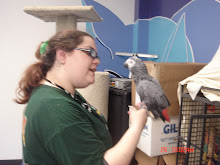
Marnie came to me just before turning 4 years old.
Marnie was born in a pet shop in Dallas, TX and her owner bought her from there. She had been given a good life with good quality food, plenty of toys and love. But her owner suffered terribly from allergies to her dust, which got to the point where she could not hold Marnie or be in the same room as her for long periods of time.
This was not fair to her or Marnie, so she came to live with me.
Marnie is now 7 years old and a healthy, well adjusted grey. She loves to lie with me on the couch under a blanket and to go out into the world. Because she is so accepting to handling, I took the time to harness train her (using the Aviator Harness, the only one I would recommend). I have taken her to a number of restaurants around Austin (we sit on the patio) and have visited local events such as the Sunset Valley Farmers Market. While she may not always be 100% comfortable out and about, the presence of food will quickly overcome fears. I find this to be a great opportunity to educate people about proper parrot care and have been able to share websites and tips with people who are having problems with their birds.

Although Marnie is harness trained, she is not flighted. When I got her I was told she often knocked out incoming feathers on one wing. I didin't think anything of it and waited patiently for the flight feathers to grow out so we could begin harnessed flight training... Well the one wing came back, but the other side kept being knocked out. After two full moults, she was still flight featherless on one wing. Since it was time for her annual veterinary exam, I took along a couple of recently knocked out feathers for Dr Davis to look at. The feathers that came in on that wing were always ratty and had stress bars, while all her other feathers came in beautifully. After a thorough physical exam, Dr Davis could not find a reason for her feathers to come in this way. The only possible explanations was that at some point she had some soft tissue damage to the wing, which lead to her being unable to grow healthy feathers. This reminded me of a story her first owner had told me of when Marnie was playing when she was less than a year old, she fell from the top of her cage and landed on her back with both wings stuck in the grate. We theorized that this was a probably source of the soft tissue injury.
Even though she cannot fly (she does a spiraling crash) I still use a harness on her when out and about. This is not only for her own safety, should that perfect combination of breeze, angle and lift come, but also as an example to other parrot owners that it is not safe to take a bird outside without either a cage or a properly fitted harness.
Marnie loves to forage for her food and gets all her main dry diet from her many foraging toys. She loves to hang out on the large playscape in my living room which she shares with Lucha, and forage in the many foraging toys I provide there.

While Marnie is no stranger to positive reinforcement, she is new to food rewards. Until last week she had no interest in food rewards. So I would wait till she performed a desired behavior and then immediately bridge "good bird" and reward her with a head scratch.
Then last week I was giving Lucha an impromptu turn around training on the playscape (instead of the training T-Stand) and Marnie decided that if the green bird was getting treats (pecans) that she wanted in on it too. So I started teaching her the turn around. She has progressed very quickly and will now turn around for a hand signal which is close to my body. I am hoping to be able to phase out the hand signal and leave the cue "Marnie Turn". Interestingly Lucha is still a few approximations behind her, even though he has had more training sessions. It just goes to show that different birds learn at different paces... or maybe there is something that I am not giving Lucha that he needs to help him learn.
Using positive reinforcement, Marnie has learned how to step down onto a scale, wear the aviator harness, turn around, have her nails trimmed and flip on her back. I plan on teaching her to wave soon and we are going to work on accepting towelling better.



Looks like Marnie has a great play area! She sounds a bit like Frank, my quaker. I have always trained him with praise, he loves it soo much. He will take treats, but I find he prefers to get a praise reward.
ReplyDeleteIt is definitely a good idea to keep her in harness, even if she can't fly. So many people still take their birds out without anything, on the presumption they will not get away, for whatever reason.